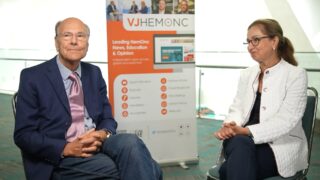This is probably one of the difficult questions in myeloma management. The first question which pops up is, which patients should receive myeloma therapy with smoldering myeloma? And there are different opinions. We can distinguish between different risk groups. We can distinguish between low-risk, intermediate, and high-risk smoldering myeloma, and we can use different algorithms...
This is probably one of the difficult questions in myeloma management. The first question which pops up is, which patients should receive myeloma therapy with smoldering myeloma? And there are different opinions. We can distinguish between different risk groups. We can distinguish between low-risk, intermediate, and high-risk smoldering myeloma, and we can use different algorithms. When we use the Mayo algorithm so patients with high-risk smoldering have a median time to progression to active myeloma of almost two years but you can improve the algorithms by adding cytogenetic data so you can improve the prediction of immediate transformation to myeloma.
In my opinion, the best selection criterion is when you apply what we call evolving phenotypes. So evolving means you have a patient with smoldering myeloma and usually a high-risk patient, and then you watch, you follow those patients, you look at hemoglobin levels. If hemoglobin is dropping, it’s a sign of evolving transformation. If the paraprotein is increasing, it’s a sign of evolving transformation. If light chains are increasing, it’s a sign of evolving transformation. And if the bone marrow infiltration percentage is increasing, it’s also a sign. So you can have these parameters, and using these parameters gives you a very good, let’s say, safety margin that you select the right patient for treatment.
So now you treat patients with early disease, and those patients, in principle, should have a longer survival because they don’t have CREB criteria, which means very severe anemia, bone lesions, renal dysfunction, and so on. So I think it’s worthwhile to follow this concept.
What I am not able to support is to include patients without these characteristics into early treatment trials, because some of those patients will not progress at all, even after 10 years, about 25%. So you need to be very careful to include the right patients for early treatment. And then the question is, what are you looking for? Of course, you are looking for improvement in survival and or at least improvement of quality of life and PFS. So if you want to ensure that your treatment improves survival, you have to have a control group. That is the issue. And it’s very difficult to run a randomized Phase III study in patients with high-risk smoldering, offering one group active disease and the other group patient wait and follow-up. But that is what basically is needed. You can use surrogate endpoints like MRD, but the gold standard is still survival. But the problem is that you have to follow your patients for long. But nowadays, this is not impossible because even if a generation is discontinuing working with myeloma, the next generation can take over, and then you can follow your patients. And at this ASH meeting there will be studies that report 10-year follow-ups of patients in a clinical study or a seven-year follow-up. So you can do that, but it takes a long time. But it’s important to show this, at least from my point of view.
This transcript is AI-generated. While we strive for accuracy, please verify this copy with the video.














